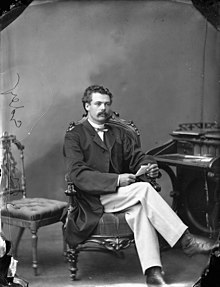Moses Chamberlain Edey
Moses Chamberlain Edey | |
|---|---|
 Moses Edey in 1869 | |
| Born | 1845 near Shawville. |
| Died | 1919 |
| Nationality | Canadian |
| Occupation | Architect |
| Buildings | Aberdeen Pavilion; Daly Building; Centretown United Church; Garland Building |
Moses Chamberlain Edey (1845–1919)[1][2] was an Ottawa architect who designed the Aberdeen Pavilion at Lansdowne Park, a National Historic Site and the Daly Building (1905-1992) which was Ottawa's first department store.
His architectural styles were Gothic, Romanesque, and Beaux Arts, with the Daly Building a Chicago style.[3] Edey had worked with Ottawa architect W.E. Noffke and Ottawa architect Francis Conroy Sullivan had once worked as a draftsman for Edey.[4]
History

Moses Edey was born 1845 in the southwestern area of Quebec,[1] of Pontiac County near Shawville. He was the second son of six children of Richard and Mary Edey, descendents of United Empire Loyalists.[1] The Edey's had been part of Philemon Wright's party (the founder of Hull, Quebec[5] when Moses Edey came to Hull, Quebec from Randolph, Vermont, in 1805.[6] Moses' father, Richard had been born in 1812 in Aylmer, Quebec. Moses designed the red-brick Methodist chapel that still stands on Vanier Road, Aylmer. Artifacts from the Mayflower still exist, the possessions of the family of Moses' mother's, whose ancestors journeyed on that famous ship.[1]
Following some time with the Casey Tool Company of Auburn, New York, he later worked for ten years in design and construction in Ottawa under an A. Sparks. Since then he concentrated on architecture.[1]

By the 1860s Moses Edey had completed apprenticeships in architecture and construction of buildings as well as in carriage design and construction.[5] He had moved to Arnprior at 17, where he worked in carriage making for 2 years, and two more in Ottawa under that trade. He then studied under Thomas in Toronto and went to Moravia, New York and studied under Z. D. Stearns[1]
During this time, he spent five years at the Ottawa School of Arts and held diplomas from the Ontario School of Art. He joined the Ontario Society of Architects.[1] After studying design at the Ottawa Art School he set up shop on Sparks Street[3]
Moses Edey married Mary Whillans from Russell, Ontario and had two children, Mabel Gertrude Mary Edey, and Isabel Maude Edey.[1]
Edey had building plans for Lansdowne Park, a fairground in Ottawa, with the centrepiece the Aberdeen Pavilion, which came to affectionately be known as the “Cattle Castle”.[5] The building sustained years of suggestions of demolition, but it was rehabilitated.
Work


- Aberdeen Pavilion at Lansdowne Park for (a.k.a. the "Cattle Castle" for the Central Canada Exhibition), which is a National Historic Site
- Daly Building (1905-1992) which was Ottawa's first department store.
- Centretown United Church
- Mountain View Chapel, chemin Vanier, Aylmer, Qc
- Garland Building (demolished) [3]
He also possibly designed:
- The Geggie Home at 801, Chemin Riverside, Wakefield, Quebec[7]
- Mount Pleasant (apparently gone), a home at 40 Riverdale Avenue (City of Ottawa has an archive picture probably CA-2954)[8]
See also
- Architecture of Ottawa and the Architecture of Ottawa#Architects section
- Aberdeen Pavilion
- Daly Building
- Centretown United Church
References
- ^ a b c d e f g h Adam 1892.
- ^ "The Family of John and Priscilla Wright: Moses Edey". Wrightfamily.ca. Retrieved 2011-09-07.
- ^ a b c Steinhauer, Mike (2011-08-15). "The Daly Building Revisited | Spacing Ottawa". Spacingottawa.ca. Retrieved 2011-09-07.
- ^ "Hintonburg Heritage Walking Tour". Hintonburg.com. Retrieved 2011-09-07.
- ^ a b c Bulldog, The. "Doucet To Host Lansdowne Architect's Descendants At City Hall | Ottawa Citizen Blogs". Blogs.ottawacitizen.com. Retrieved 2011-09-07.
- ^ "Description found in Archives – Search – Library and Archives Canada". Collectionscanada.gc.ca. Retrieved 2011-09-07.
- ^ Bed and Breakfast Online Canada Inc. "Les Trois Erables". Les Trois Erables. Retrieved 2011-09-07.
- ^ "Slattery's Field in Old Ottawa South – Ottawa's First Accidental Airfield". Oldottawasouth.ca. 2010-01-09. Retrieved 2011-09-07.
- Bibliography
- Adam, G. Mercer (1892), Prominent Men of Canada, Toronto: Canadian Biographical Pub. Co., ISBN 0-665-00030-8, 0665000308, retrieved 1 Sep 2011
External links
- Geggie home [1]
- Slattery homestead article with picture of "Mount Pleasant" [2]
- Historic Places in Canada
